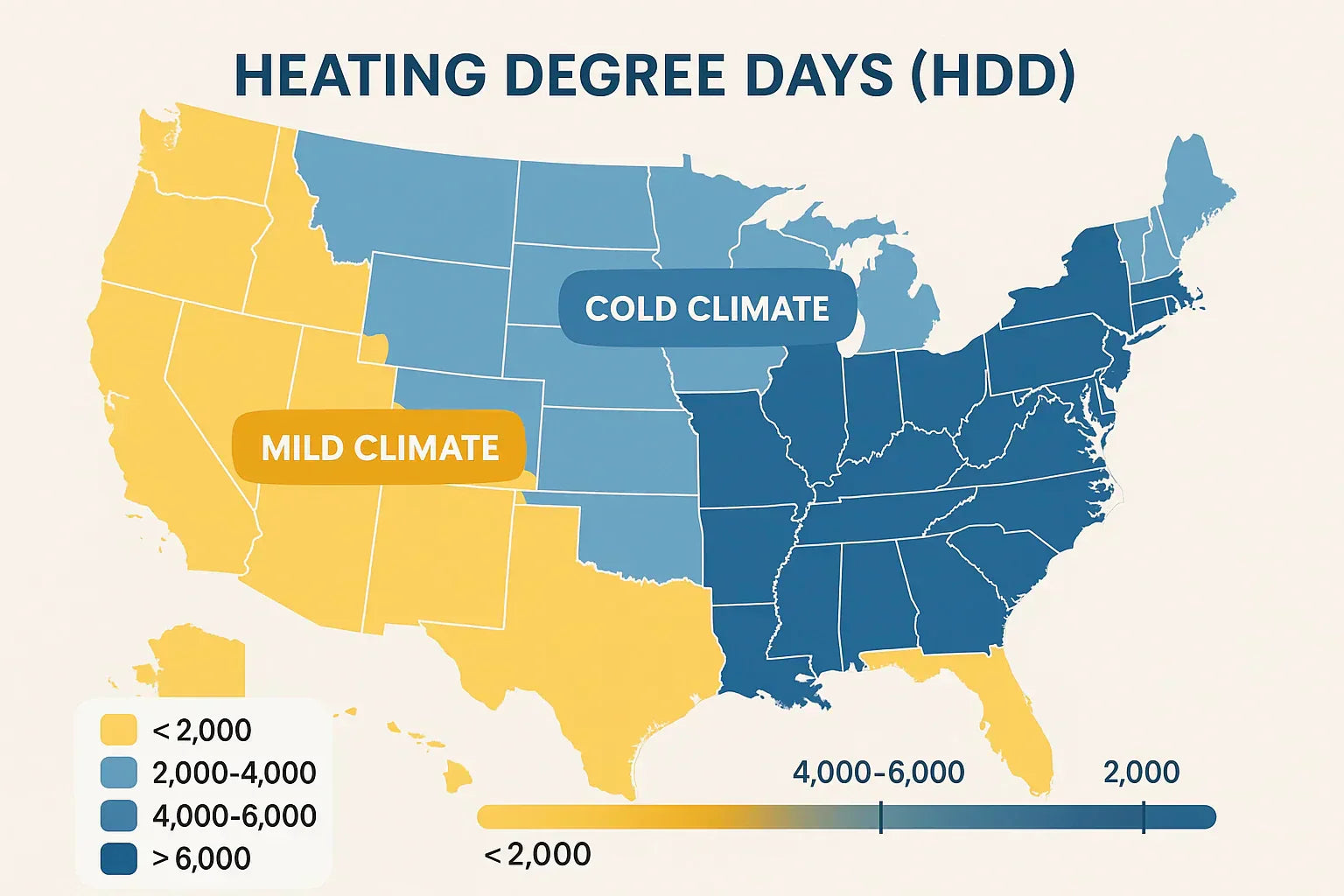By Alex Lane | Your Home Comfort Advocate
If you live somewhere that’s warm most of the year, the idea of buying a high-efficiency furnace might feel like overkill. After all, if you only run the heat a few weeks each winter, how much difference could it make?
In this post, we’ll break down whether a high-efficiency furnace makes sense in mild climates—or if your money is better spent elsewhere.
What Is a “Mild Climate” Exactly?
Understanding Heating Degree Days (HDD)
To figure out how much heating your home really needs, energy experts look at something called Heating Degree Days (HDD). It measures how often outdoor temperatures drop below 65°F (18°C), which is when you’re most likely to turn on your heat.
According to the EPA’s Heating Degree Day indicator, cities like Miami, Los Angeles, and Houston average under 1,500 HDD per year. Compare that to Minneapolis or Buffalo, which can see 6,000–9,000 HDD annually.
Examples of Mild-Climate Regions
If you’re in one of these areas, chances are you don’t rely on your furnace all that much:
-
Southern California (L.A., San Diego)
-
Gulf Coast (Houston, New Orleans)
-
South Florida (Miami, Tampa)
-
Parts of Arizona and Nevada
-
Coastal Southeast U.S.
How Often Does Your Furnace Actually Run?
Seasonal Runtime Estimates
In colder regions, a furnace might run 1,200 to 2,000 hours per year. But in mild zones, that can drop to 300–600 hours annually.
Energy.gov confirms that heating accounts for less than 25% of annual energy use in southern states—compared to 45% or more in the North.
Why Usage Frequency Affects ROI
High-efficiency furnaces save more per hour of operation. So if your furnace barely runs, you’ll save very little each month. It could take 15–20 years just to break even—which may outlast the system’s useful life.
Pros and Cons of Going High-Efficiency Anyway
Benefits Still Worth Considering
Even in warmer climates, high-efficiency units offer a few perks that go beyond fuel savings:
-
✅ Quieter operation thanks to variable-speed fans
-
✅ Sealed combustion improves indoor air quality
-
✅ Smart thermostat compatibility
-
✅ Federal tax credits up to $600 through the Inflation Reduction Act
So if your home is sealed tight and you care about comfort and noise, a high-efficiency model may still be worth it—even if the fuel savings are minor.
Downsides in Mild Climates
That said, there are also real drawbacks if your heating demand is low:
-
❌ Longer payback period (10–20+ years)
-
❌ Higher upfront cost ($1,000–$3,000 more than standard)
-
❌ More complex install and potential maintenance
The ENERGY STAR replacement guide recommends high-efficiency models for homes that use a lot of heat or have aging systems. In other cases, they suggest weighing total costs carefully.
When a Standard Furnace Makes More Sense
Simple Systems for Simple Heating Needs
If your furnace only kicks on a few dozen times each winter, you probably don’t need the top-tier equipment. A standard 80% AFUE furnace may offer plenty of comfort without the added cost or complexity.
The Department of Energy’s efficiency standards note that while minimum efficiency has improved, standard furnaces are still widely approved and effective—especially in warmer regions.
Good Candidate Homes for Standard Efficiency
A standard-efficiency furnace may be your best bet if:
-
You plan to move in the next 5 years
-
Your home is under 2,000 sq. ft. and well-insulated
-
You live in a rental or seasonal property
-
You’re on a tight budget and don’t qualify for rebates
Summary: What’s Right for Your Mild-Climate Home?
Quick Decision Checklist
| Question | Go High-Efficiency | Stick with Standard |
|---|---|---|
| Do you run your furnace < 600 hrs/year? | ❌ | ✅ |
| Planning to stay 10+ years? | ✅ | ❌ |
| Access to rebates or tax credits? | ✅ | ❌ |
| Is quiet operation important to you? | ✅ | ❌ |
| Tight budget or selling soon? | ❌ | ✅ |
🧠 Still Debating the Upgrade?
If you’re weighing the pros and cons of furnace efficiency, check out the full breakdown in our guide:
👉 High-Efficiency Furnaces: Worth the Investment?
It covers payback timelines, feature comparisons, and how to decide what’s right for your home.
📖 Next in the Series: Rebates & Incentives
Even in mild climates, rebates can tip the scales. See what credits are available in 2025:
👉 Furnace Rebates & Tax Credits for High-Efficiency Models (2025 Update)
💬 Final Thoughts from Alex Lane
If you’re in a warm state and use your furnace sparingly, a high-efficiency model might not be necessary—but that doesn’t mean it’s wrong. It really comes down to how much value you place on quiet comfort, air quality, and long-term ownership.
But if budget is tight and the furnace is barely working during winter, a standard model will keep you warm without overcomplicating things.
Whatever you choose, make sure it’s sized right and installed by a licensed pro. Even the best system can fall flat if it’s not matched to your home.
Stay comfortable,
Alex Lane
Your Home Comfort Advocate







